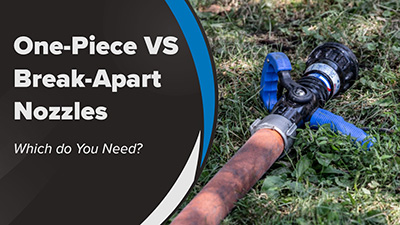One-Piece vs. Two-Piece Nozzles: Exploring the Differences
One-piece and two-piece nozzles have long been used in firefighting, providing effective solutions for various situations. As you explore your nozzle options, it is important to recognize the distinctions between these two types of nozzles and the benefits and disadvantages they offer in different firefighting scenarios.
Let’s dive into the advantages and disadvantages of each.
Two-Piece Nozzles
During your firefighting career, you have certainly faced challenges. Have you ever needed more hose line in a high-rise or made the stretch to a distant rural home only to find yourself short of the hose line you need to get through the door?
In these scenarios, a two-piece nozzle can help.
Flexibility in Challenging Scenarios
 |
 |
Typically composed of a 1.5" or 2.5" ball valve shut-off paired with a combination nozzle tip or a smooth bore tip, the two-piece nozzle offers a significant advantage in certain scenarios.
The two-piece design allows you to disconnect the nozzle tip from the ball valve shut-off. This allows for:
-
The removal of extreme debris clogs
-
Addressing issues related to poor water quality
-
Break-and-extend operations
-
Switching smooth bore tip sizes with a charged line
-
Removing and replacing a damaged nozzle tip with a charged line
Although this disconnection may momentarily interrupt your stretch or tactical objectives, it benefits your engine company team by keeping the hose line fully charged and ready for immediate action. By simply re-attaching the nozzle tip, you and your crew can swiftly resume operations.
Two-Piece Nozzle Considerations
If your fire department undergoes operational changes every decade or so or plans to evaluate another type of nozzle in the future, the two-piece nozzle gives you the ability to change easily. These nozzles give you the flexibility to switch nozzle tips while keeping the same shut-off ball valve.
This provides two separate benefits:
-
Nozzle evaluation is simple since you can take off your current nozzle tip and replace it with the one you are evaluating
-
During nozzle purchases you can see cost savings as you are able to replace the tip only and keep your current valves.
One-Piece Nozzles

If challenges like extreme clogs, the need for added hose, or changing nozzle tips are not prevalent in your response district, a one-piece nozzle can be equally effective in fire suppression efforts.
Simplicity and Adaptability
One-piece nozzles come in smooth bore or combination variations, with options for fixed, selectable, or automatic operation at operating pressures ranging from 50 to 100 PSI.
One-piece nozzles are easy to use, allowing you to turn them on or off and adjust the nozzle tip as needed. However, it is important to note that when encountering situations that require more hose, switching nozzle tips, or clearing extreme clogs, the entire nozzle assembly must be disconnected, temporarily interrupting the operation. While this process may take some time, it can still be effectively executed with a one-piece nozzle.
Valve Choice: Considerations for One-Piece Nozzles
The choice of valve is another critical factor when selecting a one-piece nozzle. Traditionally, handheld operations used a ball valve, which only had two positions: fully open or fully closed. Adjusting the valve in between these positions, or gating the valve, would disrupt your water stream, reduce flow rate, and result in an ineffective broken stream. However, in the late 1970s, the slide valve was patented, introducing an alternative for one-piece nozzles.

The slide valve enables multiple positions without interrupting the water stream, ensuring a consistent straight stream. Although it also reduces flow rate, it facilitates effective flow control and maneuvering tactics. Fire departments worldwide, especially those using pulsing nozzle techniques, prefer the slide valve due to its ability to introduce short, fast bursts of water into the fire environment as firefighters advance towards the fire room, enhancing control and efficiency.
Considerations for Choosing the Right Nozzle
The choice between a one-piece and a two-piece nozzle depends on several factors, including tactical considerations, department traditions, and your standard operating procedures. It is crucial to understand the reasoning behind your choice, evaluate available options, receive proper training on the chosen tool, and keep an open mindset for continuous learning throughout your firefighting journey.
